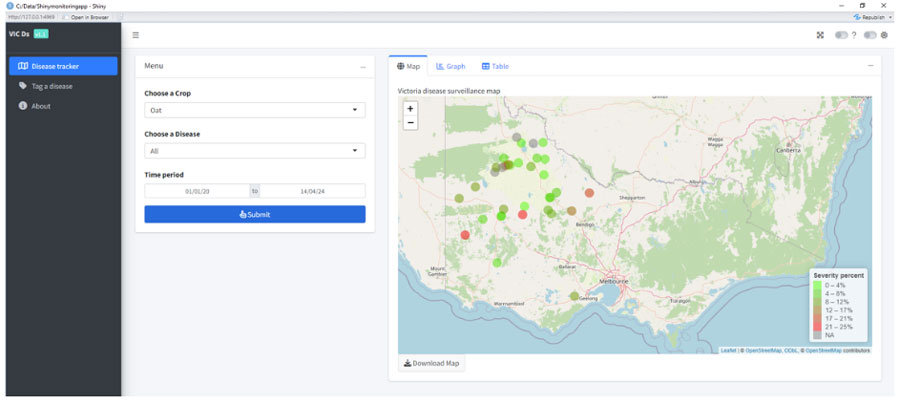The productivity of research activity and the quality of outcomes has received a leg-up from a crop pathologist’s internship with Analytics for the Australian Grains Industry.
While laboratory and controlled-environment research equipped Dr Hari Dadu to be an experienced laboratory-based pathologist, he saw that more could be done if he could complement this with field-based research.
To make this a reality, Dr Dadu applied for an internship with GRDC-supported Analytics for the Australian Grains Industry (AAGI) to gain expertise in designing and analysing field trials, which are subject to greater spatial and temporal variation compared to controlled-environment studies.
The six-week research internship covered numerous analytically aligned topics such as data preparation, statistical modelling and building applications for broad dissemination of project results. Specific topics were:
- data diagnostics and preparation of data in a statistical software computing environment known as ‘R’;
- generating spatially optimal model-based designs for experimental controlled and field environment trials;
- introduction to computational statistical models to analyse complex agronomic data; and
- building and deploying new online applications that display and disseminate analysis results from the national disease management trials.
Research internship AAGI supervisors were Dr Beata Sznajder, Sam Rogers and Russell Edson, who are all based at the University of Adelaide’s Biometry Hub led by Dr Olena Kravchuk and deputy Dr Julian Taylor.
Dr Dadu, a senior research scientist from Agriculture Victoria’s Horsham SmartFarm, is a member of the field crops pathology team. His responsibilities include developing disease management strategies, conducting disease surveillance and screening germplasm for new fungal resistances for cereal crops.
He completed his PhD at the University of Melbourne in 2019 focusing on identifying and characterising resistance sources to Ascochyta blight within exotic lentil germplasm. To meet the demands of this role, which includes field-based research, Dr Dadu sought to upgrade his skills.
He says the first component of the internship involved analysis of historical data produced in the GRDC-supported national barley foliar pathogens project and investigation of the virulence of Pyrenophora teres maculata (the causal organism of spot form of net blotch disease, SFNB) within the Australian population.
“This was achieved using the statistical coding package ‘R’ and the linear mixed modelling package ASReml-R. The results showed variation in the virulence of SFNBpopulations and presented isolates of concern for the industry,” Dr Dadu says.
He then developed a cloud-based Shiny app to assist Agriculture Victoria’s disease surveillance activity (Figure 1).
Figure 1: An interactive Shiny app tool for plant disease surveillance will help users record passport data and monitor the prevalence of the disease within a region.

Source: Hari Dadu, Agriculture Victoria
“The aim of the app was to assist researchers to capture passport data of a disease sample during surveys and produce a quick summary through various data visualisation forms such as a map, table and graph for direct incorporation into project reports.”
Through the internship Dr Dadu has developed the app named ‘Victoria Disease Surveillance’ and published it on a Shiny server for use during the season.
The new statistical and computing skill set obtained through the internship has improved my ability to generate experimental designs, perform complex data analysis tasks using R and develop useful cloud-based applications for our team to use.
“This has improved our research productivity as well as the quality of our research outcomes.”
Dr Dadu is now applying this new skill set to develop insights into the environmental effects of Septoria tritici blotch (STB) incidence in wheat, another GRDC research investment.
Dr Julian Taylor says that after Dr Dadu completed the internship, his analytical capabilities have grown significantly. For the STB work, Dr Dadu has generated most of the annual experimental field trial designs and undertaken the analysis of phenotypes.
“AAGI will continue to provide collaborative analytical support in 2024 for a more-complex integrated multi-environment analysis of STB phenotype and associated traits that are being collected by Dr Dadu and his team,” Dr Taylor says.
More information: Dr Hari Dadu, hari.dadu@agriculture.vic.gov.au

























































